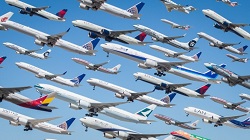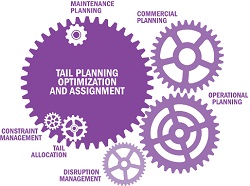I love airports. Perhaps it is the time of year or the fact that every time I step into an airport I am reminded of that endearing scene from Love Actually, “Whenever I get gloomy with the state of the world, I think about the arrivals gate at Heathrow Airport. General opinion’s starting to make out that we live in a world of hatred and greed, but I don’t see that. It seems to me that love is everywhere. Often it’s not particularly dignified or newsworthy, but it’s always there – fathers and sons, mothers and daughters, husbands and wives, boyfriends, girlfriends, old friends.”
 Travel keeps the world turning, transporting us for business, for family, for love. At the busiest travel time of the year, it has dawned on me that in the hustle and bustle, I have never really stopped to think about all the intricacies and detailed planning that goes into keeping air travel smooth and safe for the millions of travelers that take advantage on a day-to-day basis. These composite images, captured by photographer Mike Kelley, perfectly capture the thousands of airlines that have transformed the way we travel and do trade.
Travel keeps the world turning, transporting us for business, for family, for love. At the busiest travel time of the year, it has dawned on me that in the hustle and bustle, I have never really stopped to think about all the intricacies and detailed planning that goes into keeping air travel smooth and safe for the millions of travelers that take advantage on a day-to-day basis. These composite images, captured by photographer Mike Kelley, perfectly capture the thousands of airlines that have transformed the way we travel and do trade.
So how do the largest civil aviation organizations of the world find the right balance between the imperative scientific nature of fleet operations needed to meet compliance regulations and the importance of delighting customers?
THE CURRENT STATE OF AIRLINE OPERATION
The truth is, maintaining this equilibrium is hard work, especially because it is riddled with human response and error. A typical airline has a team spending some 3-4 hours to prepare a single day’s optimized plan and a 24-hour shift to cope with unplanned variability and dynamic disruptive events – and complexity can quickly compound with each interlinked, unfolding issue. Managing the unexpected is a constant challenge in civil aviation, with such little control over external elements like weather, airport delays and more. Surely, with the technology that exists today, there is a better way to optimize and mitigate risk.
THE FUTURE OF FLEET OPTIMIZATION
 Tail planning optimization and assignment (TPOA) combines strategic, optimized scheduling with real-time operational visibility to provide airline organizations with the ability to maximize aircraft allocation efficiency, support aircraft planning and optimally schedules maintenance events. Thanks to this combination of intelligent operational tools, airlines can now make real-time data-driven decisions, responding to change and the unexpected faster and more effectively. Airlines need a solution today that will help them to reduce risk, increase ULR (ultra-long range) efficiency and improve fleet utilization and maintenance planning. TPOA does this while providing performance visibility needed to make continual improvements to efficiency, safety and customer satisfaction.
Tail planning optimization and assignment (TPOA) combines strategic, optimized scheduling with real-time operational visibility to provide airline organizations with the ability to maximize aircraft allocation efficiency, support aircraft planning and optimally schedules maintenance events. Thanks to this combination of intelligent operational tools, airlines can now make real-time data-driven decisions, responding to change and the unexpected faster and more effectively. Airlines need a solution today that will help them to reduce risk, increase ULR (ultra-long range) efficiency and improve fleet utilization and maintenance planning. TPOA does this while providing performance visibility needed to make continual improvements to efficiency, safety and customer satisfaction.
PREPARING FOR WHAT’S ON THE HORIZON
The International Air Transport Association (IATA) expects air passenger growth to double by 2035, expecting 7.2 billion people to travel by air over the next 20 years. The changing technological landscape is determining a rise in customer expectations and a more competitive market. The development of new airplanes like Richard Branson’s supersonic Boom jet and the new Concorde 2 set to fly in 2021 add new challenges to fleet management and airline planning and forecasting. Airlines that mitigate these challenges with a fleet optimization solution today will be able to better prepare for the futures’ expectations. As we stand in front of arrival boards and peer out windows while flying among the clouds, the airlines that take advantage of today’s emerging technologies are already transforming the travel experience so that someday, in the near future, it might only take 11 minutes to travel from New York to London, and airport delays might be something the old folk complain about like walking uphill to school both ways…
Do you have questions or comments?
We’d love to hear them so please leave us a message below.
Shayur Maharaj
Great piece Kristina, I think that innovation and adaptability is so important. Thanks for sharing your view on this within the airline sector.